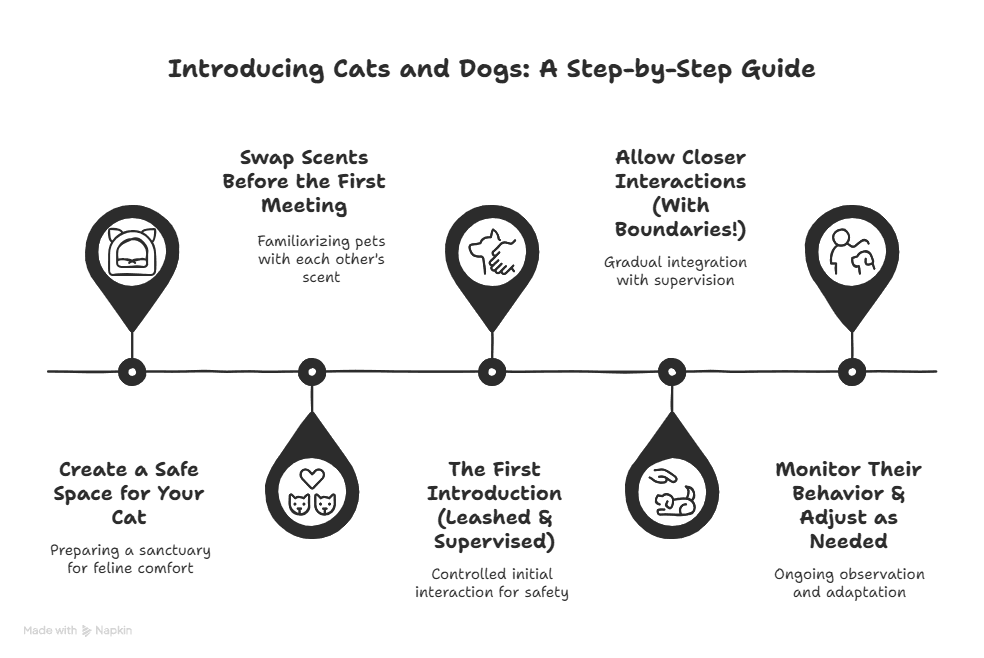
Bringing a new cat into a home with a dog (or vice versa) can feel like a big challenge. You might be wondering: Will they get along? Will they fight? How to introduce cats to dogs the right way can make all the difference in creating a peaceful home for everyone.
The truth is, while some cats and dogs become best friends, others may simply learn to tolerate each other—and that’s okay! The key to success is a slow, thoughtful introduction that respects both animals’ needs.
If you’re preparing to introduce a cat and a dog for the first time, here’s a step-by-step approach to making the process smooth, safe, and stress-free.
Understanding the Differences Between Cats & Dogs
Before the first introduction, it helps to understand how cats and dogs communicate differently.
🐶 Dogs: Social animals that often seek play and interaction. Some breeds are excitable and may view a cat as a chase-worthy toy.
🐱 Cats: Independent and territorial. Many fear larger animals and may see an energetic dog as a potential threat.
Because of these natural differences, forcing an introduction too quickly can lead to stress, fear, or even aggression.
💡 Tip: If your dog has a strong prey drive (such as a Husky or Terrier), take extra precautions. Some breeds have a natural instinct to chase small animals, making introductions more challenging.
Step-by-Step Guide on How to Introduce Cats to Dogs

Step 1: Create a Safe Space for Your Cat
Before meeting face-to-face, your cat needs a safe retreat where they feel secure. Set up a separate room with:
✔️ Food, water, and a litter box.
✔️ A cozy bed and hiding spots.
✔️ A cat tree or high shelf (cats feel safer in elevated spaces).
This gives your cat time to adjust to the new home environment before meeting the dog.
Step 2: Swap Scents Before the First Meeting
Scent is a big deal for both cats and dogs—it’s how they recognize friend from foe.
✔️ Swap bedding or blankets between the two pets so they get used to each other’s smell.
✔️ Rub a towel on one pet and place it near the other’s resting area.
✔️ Feed them on opposite sides of a closed door so they associate each other’s scent with something positive (like food).
Doing this for a few days helps create a sense of familiarity before they meet.
Step 3: The First Introduction (Leashed & Supervised)
Once both pets seem comfortable with each other’s scent, it’s time for a controlled first meeting.
1️⃣ Keep the dog on a leash and allow the cat to roam freely.
2️⃣ Let them observe each other from a safe distance—no forcing interaction!
3️⃣ Reward calm behavior with treats and praise.
4️⃣ If either pet seems stressed (growling, hissing, barking), end the session and try again later.
💡 Tip: Keep these early sessions short (5–10 minutes) and repeat daily, increasing their time together gradually.
Step 4: Allow Closer Interactions (With Boundaries!)
If both pets seem comfortable after a few meetings, allow closer supervised interactions:
✔️ Use a baby gate or barrier so they can interact safely.
✔️ Allow your cat to approach at their own pace.
✔️ If they’re curious and sniff each other, that’s a great sign!
✔️ If either pet seems overwhelmed, slow down the process.
💡 Tip: Always give your cat an escape route—a high perch or nearby doorway—to help them feel in control.
Step 5: Monitor Their Behavior & Adjust as Needed
Some pets warm up to each other in a few days, while others take weeks or even months to fully adjust.
✔️ Positive signs: Sniffing, relaxed body language, playful curiosity.
❌ Warning signs: Persistent barking, chasing, hissing, raised fur.
If your dog is overly fixated on the cat or keeps trying to chase them, work on redirecting their energy with training and exercise.
Common Problems & How to Solve Them
Even with a good introduction, some issues can arise. Here’s how to handle the most common problems:
1. My Dog Won’t Stop Chasing the Cat!
Dogs with a high prey drive may instinctively chase small, fast-moving animals like cats.
✔️ Teach the command “leave it” or “stay” and reward calm behavior.
✔️ Keep playtime separate until they can coexist peacefully.
✔️ If chasing continues, consider professional training.
2. My Cat Keeps Hissing or Swatting at the Dog!
A little hissing is normal at first—it’s how cats set boundaries.
✔️ Allow more time for scent swapping before forcing interactions.
✔️ Let the cat observe the dog from a safe spot before another meeting.
✔️ Avoid forcing them into the same room if the cat seems scared.
3. My Pets Keep Fighting Over Food or Space!
Sharing isn’t always easy, especially for territorial animals.
✔️ Feed your cat and dog in separate areas to prevent food aggression.
✔️ Make sure your cat’s litter box is in a dog-free zone.
✔️ Use baby gates or cat trees to create cat-only spaces.
Long-Term Tips for a Happy Cat-Dog Household
Once your pets accept each other, focus on building long-term harmony:
✔️ Provide separate spaces—even friendly pets need alone time.
✔️ Continue rewarding positive interactions with treats and praise.
✔️ Monitor their playtime—some dogs play rough, and not all cats enjoy that!
✔️ Keep your dog well-exercised so they don’t take out their extra energy on the cat.
💡 Tip: Some pets may never cuddle or play together, and that’s okay! As long as they coexist peacefully, you’ve done your job.
FAQs
Q: How long does it take for a cat and dog to get along?
It depends! Some adjust in a few days, while others take weeks or even months.
Q: What dog breeds get along best with cats?
Breeds like Golden Retrievers, Labrador Retrievers, Poodles, and Cavalier King Charles Spaniels tend to be more cat-friendly.
Q: What if my cat and dog never become friends?
That’s okay! As long as they respect each other’s space and don’t fight, peaceful coexistence is a success.
Also Read - Training Your Cat to Respond to Their Name: A Step-by-Step Guide
Final Thoughts
Introducing a cat to a dog takes patience, preparation, and the right approach.
🐾 Start with scent swapping and short, supervised meetings.
🐾 Give your cat plenty of escape routes.
🐾 Reward calm, positive interactions to encourage trust.
With time and consistency, your cat and dog can live together happily—whether as best friends or just peaceful roommates!
💬 Have you introduced a cat to a dog before? Share your experience in the comments! 🐱🐶👇




